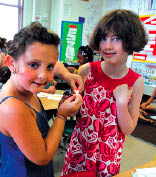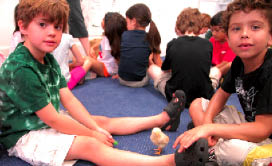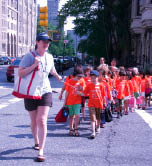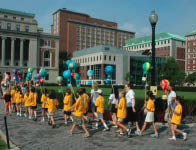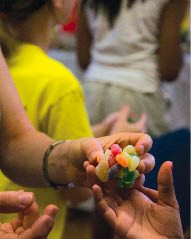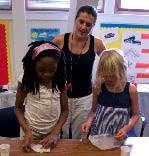Seek and Ye Shall Find
Discovery is the stock-in-trade of TC's Hollingworth Science Camp
Discovery is the stock-in-trade of TC’s Hollingworth Science Camp
by Jonathan Sapers
On July 26, to the relief and amazement of a group of seven-year-olds in the Hollingworth Science Camp at Teachers College, 13 chicks were born in a classroom on the fifth floor of Zankel Hall.
Marshall Schechter and his classmates sat in pairs on the floor, providing the chicks their first encounter with human hands and linoleum.
Right away, Marshall, realized something about the chick he was holding. “He chirps a lot when he’s on the ground, but when he’s being held, he doesn’t chirp at all. I think he feels comfortable in our hands because our body temperature is the same as his body temperature.”
“Marshall, I think you’re on to something,” said Michele Damiano, the Camp’s co-director. “But what happens when you’re not here? Because people and chicks in nature don’t always live together, right?”
“Well, when we’re not there, probably they ruffle up,” Marshall responded. “Like in the cage, they’re piling on top of each other. That’s what they do. When they get cold, they pile on top of each other.”
For the past 15 years, Hollingworth, which operates during the month of July in classrooms on the upper two floors of Zankel, has been providing children and students in TC’s preservice teaching programs a chance to spend a month intensely focusing on science.
Discovery is the Camp’s stock-in-trade: the 200 children who attend each year are divided into groups called, appropriately, Experimenters, Detectives, Investigators, Observers, Sleuths, Explorers, Innovators and Inquirers. Under the tutelage of 40 teachers, all TC alumni or current students, they pursue knowledge of the human body, botany, life cycles, energy, simple machines, geology, flight, structures and an overarching, separate general theme for the whole Camp (this year’s was astronomy). They learn not by hearing lectures or reading textbooks but by asking questions, experimenting and following their own instincts, even if those lead them in the wrong direction. They also take swimming, go on field trips and make special science-themed Fourth of July Ice Cream Sundaes. This year’s featured comet swirls and star toppings.
The camp’s rituals have become a familiar sight around TC: the younger campers in their brightly colored Hollingworth tee-shirts, gripping the rope line known, for mysterious reasons, as “Wilbur,” as they traverse the halls and surrounding streets; the end-of-July parade across the Columbia campus, the children bearing huge pinwheels, paper-mâché volcanoes and other samples of their work, while parents and other onlookers cheer them on from the steps of Low Library. Like any really good camp, Hollingworth also has become a tradition for many families, with younger siblings following in the footsteps of older ones. This summer’s crop included Jacob Shaw, 6, younger brother of Rebecca, 15 (who says she still calls upon Hollingworth science jingles when she gets stuck in school), and Adam, 12; and Victoria Vanriele, 8, younger sister of Arlene Douglas, 19 (now at Princeton, where, thanks to the time spent in the TC pool during her Hollingworth summers, she is on the varsity swim team).
The Hollingworth Summer Camp is one of three programs run by the Hollingworth Center, founded in 1981 by TC Professor James Borland and Heidi Hayes Jacobs, a TC alumna who is the founder of Curriculum Designers, Inc. The Camp’s focus echoes the work of the Center’s namesake, Leta Hollingworth, a TC psychologist during the early 20th century who explored “the curriculum of common things”—stuff found in everyday life, which appeals to kids’ natural predilection for inquiry.
“They may not call it science, but if you think of children looking at pigeons in the park or the changing of the leaves, very, very little children are very keen observers and they’re keen observers as things change,” says Lisa Wright, a blond, cheerful woman with a kindly manner who became Hollingworth’s director in 1987. “And of course that’s the same type of keen observation we use in science.”
But something happens to kids as they get older. “When children enter formal school and science becomes identified as something you do on Tuesdays from two to two-thirty, it becomes very watered down. It goes from being something very dynamic to being very static. Children begin to dislike science.”
The goal of Hollingworth, then, is to engage children’s natural curiosity and propensity for science. “When you’re five or six years old, what is the most interesting thing? Well, yourself, of course. And how fascinating is it to learn how you work? So our youngest children study the human body,” Wright says. “The body is made of systems. And how are your systems orchestrated? Through the brain. So we start studying the brain and doing hands-on activities with them so that they can see how their brain works. We make Jell-O molds in the shapes of brains. We identify different parts of the brains. They cut the brains. And then they go on to other systems. And again, complete immersion. When they study the heart, they’ll have a big, huge simulated heart that is made of red and blue rope, and the kids walk through the arteries of the heart and they use stethoscopes and they gather information and a deeper understanding.”
The trick is to make that understanding stick—and that happens best, Wright says, when kids are taught by someone who gets genuinely excited along with them.
“What gets kids interested in science is the level of responsiveness of the person who’s sharing the journey with them. So if we’re doing the human body, and I can anticipate developmentally because of your age and because of my experience that you are probably going to be interested in this if I present it in a way that engages you, and I bring a sense of wonder and an excitement and a shared collaboration, I am going to engage you. Think about New York City buildings standing up, which our kids study—that really is amazing, right? And then when children are excited, what is your capacity to share that joy of inquiry with them?”
On the same morning as the great chick nativity, Betsy Buecker, head teacher and TC alumna, assigned her eight-year-old Explorers an experiment: in the next 10 minutes, could they possibly form metamorphic rock using gumdrops and wax paper? Metamorphic rock is usually formed when crystals and rocks are pressed together with heat over many, many years. In this case heat was to be formed by the students’ bodies and ingenuity; minutes would have to stand in for centuries.
First, though, an admonishment from Buecker: “If this is science material, do we eat it?” she asked.
“No,” the children replied, dutifully.
Soon the kids were wrapping the gumdrops in wax paper and furiously mashing them together. “I rolled them into a ball, and I sat on it,” said Wolf Gilligan. “Then I put them under the leg of my chair.”
“Excellent,” Buecker remarked.
At another table, a child reported an important observation. “If you break the gumdrops in half and you put them back together, they stick together way better than if you just mash them up.”
“Wait, wait, why does that sound familiar to me?” Buecker asked the group, triumphantly. “What have we been talking about, about sandstone?” Earlier she had been explaining how sedimentary rock like sandstone forms when bits of rock, shells and sand get packed together. Metamorphic rock is the result when either sedimentary rock or another type of rock, igneous rock, is formed by heat and pressure.
“Rock erodes to be put back together again and when it changes into metamorphic rock, then what happens? What’s going to happen to it next?”
“It’s going to break apart,” a child said.
“It’s going to start breaking apart again. What are we doing? A cycle, yes, and what kind of—”
“A cycle of rocks.”
“The cycle of rocks. The rock cycle, and you just did the whole rock cycle with a gumdrop. Whoa. Crazy,” Buecker said, happily.
For Hollingworth’s teachers, the Camp is a rare chance to really focus on science. “The opportunity to teach science in an elementary grade classroom is very limited,” Wright says. “Science might be taught once a week, at most, twice. Some schools, the teacher doesn’t teach science. It’s a cluster. It’s a special teacher.”
Throughout the summer at Hollingworth, “the assistant teachers, all TC preservice students, will receive staff development that’s targeted just for them,” Wright said. “So, for example, we just did a session with our assistant teachers on field trips, and how do you help mediate the environment when you’re going to a science exhibit with young children. Those opportunities are built in.”
Laura King Casey came to Hollingworth after completing her master’s at TC on a prestigious Petrie Fellowship. Her first summer, she worked as a jack-of-all-trades at the Camp, “helping out, going on field trips.” When she was asked to return the following summer, she didn’t hesitate. “Hollingworth to me is like the ultimate school. It’s like school under the best circumstances because not only is it the most supportive environment for you, if you have questions. If you need advice, you know we’ve got the best people to go to.”
Of course the hope is that the teachers will go on to do even more good for kids if they take the experience and curriculum they learned at Hollingworth back to their inservice placements and full-time teaching jobs. When they do, Wright says, they “report back the same kinds of enthusiasm and engagement.”
For example, Damiano taught for two years at a school in New Jersey, came to Hollingworth and went back to New Jersey with a completely changed approach. “I always thought I had integrated science, and then I started working at Hollingworth and my idea of how to integrate science changed drastically. I think some of it was, I wasn’t aware of how I had done science with my children. I don’t think I made it clear to them that we were doing science. I realized their perception of science was men in white coats mixing chemicals. That was a big shift for me to think about making it really explicit and trying to get the idea across to my kids that anyone can be a scientist, and there’s all different kinds of scientists, and this is how scientists think. And that the way a scientist thinks isn’t limited to science.”
The shift was impressive.
“That following year I based my entire curriculum around science and we investigated everything from earth and volcanoes to electricity. We ended up, based on the kids’ interest, doing a huge unit on entomology. We had a classroom full of bugs. I had about eight or nine different bugs that the kids took care of. They turned into researchers.”
Now Damiano teaches full time during the year at The School at Columbia University and works part time at Hollingworth. But Damiano says that even though she and her friends spend the majority of the year teaching at other places, the creative spark of Hollingworth informs their teaching year round. “Our conversations throughout the year revolve around, ‘What are we doing in our classrooms?’ And, ‘Oh my gosh, I had this fabulous idea for the summer.’”
In a sense, one measure of the program’s success is how deep the kids want to go, or how complex their understanding of what a scientist is becomes. The children at Hollingworth also go through the transformation Damiano described: before they come, the children are asked to draw a picture of themselves as scientists. Almost invariably, the first pictures they draw show themselves wearing white coats and sitting with a test tube in a lab. But by the end of the summer, the children have moved on to specifics, describing themselves as oceanographers, astronomers and volcanologists.
Victoria Vanriele, in her first year at camp, was interested in art. But the summer’s theme, astronomy, particularly grabbed her interest. She had made a model of a comet, and she said she’d learned comets were “frozen gasses that have a tail at the end.” She asked an interviewer how so many stars could come up at one time.
After Victoria saw the portable Starlab planetarium that was brought into the Camp one day, her mother, Jewel Douglas, brought her to the library where Douglas said, they took out a “slew of books” on astronomy. “She saw that there are hundreds of billions of stars. Some way older than others. And she wondered whether one star had another one. Did one star have a baby?”
Scientists, too, seem to beget more of the same. The Shaw clan’s father is David, a senior research fellow at the Center For Computational Biology and Bioinformatics at Columbia. Their grandmother was a high school chemistry teacher. And their mother Beth Shaw, a non-scientist, says Jacob has made it clear he wants to be a scientist. According to family lore, when Jacob first heard about the program, at age two, he began itching to attend.
“I always wanted to be in science,” Jacob said one day as Camp was winding down this summer. “When I heard about when Rebecca and Adam went to Hollingworth, I was, like, ‘Oh, I want to go.’ I was expecting it to be less fun than this, but this is a world that a kid loves.”
“Are you kind of a scientist, Jakie?” his brother Adam asked, appreciatively.
“Yes, I think, apparently, that is correct,” Jacob responded.
To learn more about TC’s Hollingworth Science Camp, visit: www.tc.edu/HollingworthScienceCamp.
Published Wednesday, Dec. 15, 2010
